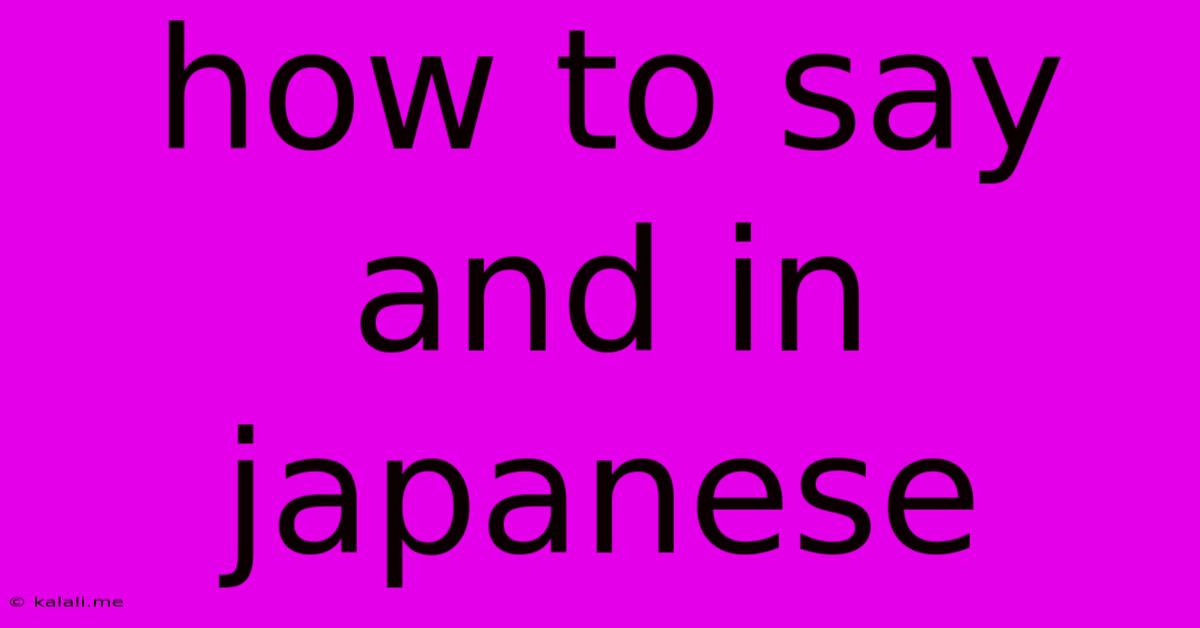How To Say And In Japanese
Kalali
May 19, 2025 · 3 min read

Table of Contents
How to Say "And" in Japanese: A Comprehensive Guide
So, you're learning Japanese and you've hit a snag: how do you say "and"? It's not as straightforward as you might think! Japanese doesn't have a single, direct equivalent to the English word "and." The best choice depends heavily on the context. This guide will explore the various ways to express "and" in Japanese, helping you choose the most natural and grammatically correct option for your situation.
This article covers different conjunctions, their usage, and provides examples to solidify your understanding of how to seamlessly integrate "and" into your Japanese sentences. Mastering this will significantly improve the fluency and naturalness of your Japanese communication.
The Most Common Ways to Say "And" in Japanese
Several words and particles function similarly to "and" in English. Here are some of the most frequently used:
-
と (to): This is probably the closest equivalent to "and" and is used to connect nouns and noun phrases. It indicates a simple additive relationship. Think of it as "and" in a list or when joining two subjects.
- Example: リンゴとバナナ (ringo to banana) - Apple and banana.
- Example: 太郎と次郎は友達です。(Tarou to Jirou wa tomodachi desu.) - Taro and Jiro are friends.
-
や (ya): Similar to "to," but "ya" implies that the list is not exhaustive. It's like saying "and others" or "and so on."
- Example: リンゴやバナナ (ringo ya banana) - Apples, bananas, and other fruits.
-
そして (soshite): This is a more formal and versatile conjunction that works well in longer sentences or narratives. It acts more like "and then" or "and after that," implying a sequential relationship.
- Example: 勉強して、そして寝ます。(Benkyou shite, soshite nemasu.) - I studied, and then I slept.
-
それから (sorekara): Similar to "soshite," but it usually emphasizes a temporal sequence, like "and then" or "after that."
- Example: ご飯を食べて、それから散歩に行きました。(Gohan o tabete, sorekara sanpo ni ikimashita.) - I ate dinner, and then I went for a walk.
Choosing the Right Conjunction: Context is Key
The best way to say "and" in Japanese depends entirely on the context. Consider these factors:
- Type of words being connected: Are you joining nouns, verbs, clauses, or adjectives? "To" is best for nouns, while "soshite" and "sorekara" are better for clauses.
- Relationship between elements: Is the relationship additive, sequential, or inclusive? "To" is additive, "soshite" and "sorekara" are sequential, and "ya" is inclusive but incomplete.
- Formality of the situation: "Soshite" is more formal than "to."
Beyond the Basics: More nuanced ways to express "and"
While the above examples cover the most common situations, there are more subtle ways to express the concept of "and" in Japanese. These often depend on the specific nuance you want to convey.
- Besides, also: Words like また (mata) or も (mo) can be used to add something extra, expressing "and also" or "besides."
Practice Makes Perfect
The best way to master using "and" in Japanese is through practice. Try incorporating these conjunctions into your sentences and conversations. Pay attention to how native speakers use them to get a feel for the natural flow of the language. Don't be afraid to make mistakes; they're a crucial part of the learning process!
This comprehensive guide should give you a solid foundation for understanding and using different ways to say "and" in Japanese. Remember to consider the context and choose the most appropriate conjunction to express your meaning clearly and naturally. Good luck with your Japanese studies!
Latest Posts
Latest Posts
-
How Do I Get Diesel Out Of Clothes
May 19, 2025
-
A Rising Tide Raises All Boats
May 19, 2025
-
Size Of A Directory In Linux
May 19, 2025
-
What Color Is A Masonry Drill Bit
May 19, 2025
-
French For It Is What It Is
May 19, 2025
Related Post
Thank you for visiting our website which covers about How To Say And In Japanese . We hope the information provided has been useful to you. Feel free to contact us if you have any questions or need further assistance. See you next time and don't miss to bookmark.